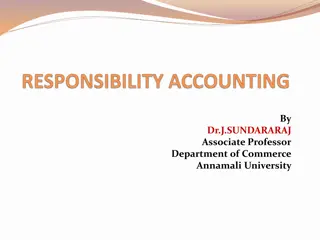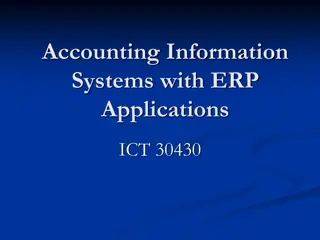Responsibility Accounting in Organizations - Key Concepts and Principles
Responsibility accounting is a system that recognizes decision centers in an organization and links costs to individual managers responsible for decisions. Principles include tracing costs directly to responsible units, setting clear goals, and reporting variances for performance evaluation. Pre-requisites involve defining areas of responsibility, stating goals, and controlling revenues and expenses. Steps include identifying responsibility centers, setting budgets, continuous appraisal, variance reporting, and taking corrective measures. Various types of responsibility centers exist, such as cost or expense centers managed by specific individuals.
Download Presentation

Please find below an Image/Link to download the presentation.
The content on the website is provided AS IS for your information and personal use only. It may not be sold, licensed, or shared on other websites without obtaining consent from the author. Download presentation by click this link. If you encounter any issues during the download, it is possible that the publisher has removed the file from their server.
E N D
Presentation Transcript
UNIT-4 TOPIC- RESPONSIBILITY ACCOUNTING (with reference to S.N. Mittal) (M.Com. (Previous year) PRESENTED BY Aakansha Dahiya Assistant Professor Kanya Mahavidyalaya, Kharkhoda
DEFINITIONS According to Charles T. Horngren, Responsibility accounting is a system of recognises various decision centres throughout an organisation and traces costs to the individual managers who are primarily responsible for making decisions about the costs in question . Eric L. Kohler defines responsibility accounting as a method of accounting identified with persons assigned to their control rather than with products or functions . accounting that in which costs are
PRINCIPLES OF RESPONSIBILITY ACCOUNTING Costs and revenues should be traced directly to the units responsible for them. Costs should be traced directly to the department which has the power to accept and pay for them. Variances form the budget and comparisons between the budget and actual results must be grounded firmly in a discernibly uniform and clearly comparable system of budgeting and reporting.
PRE-REQUISITES FOR RESPONSIBILITY ACCOUNTING The area of responsibility and authority associated with each centre should be properly defined at the outset. The set of goals which are required to be achieved by each head of a responsibility centre should be stated. The revenues, expenses, profits and investments required to be controlled by the manager of respective centres. Important items requiring management s attention should clearly be highlighted in the performance report of each responsibility centre e.g. variances. While laying down the goals or objectives of the responsibility centres, respective managers should be consult.
STEPS INVOLVED Determination of Responsibility centres. Identification of apportioned costs. Setting budgets or targets. Continuous appraisal. Reporting of variances. Corrective measures. Incentives.
RESPONSIBILTY CENTRES In the words of Deakin and Maher . A A responsibility responsibility centre orgnisation orgnisation assigned assigned to to a a manager responsible responsible for for its its operations centre is is a a specific manager who operations and specific unit unit of of an an who is is held resources . . held and resources
TYPES OF RESPONSIBILTY CENTRE Cost or expense centre These are segments in which managers are responsible for costs incurred but have no revenue responsibilities. It is essential to differentiate between controllable costs and uncontrollable costs while judging the performance of such centres. A manager responsible for a particular cost centre will be held responsible for only controllable costs.
REVENUE CENTRE It is a centre mainly devoted to raising revenue with no responsibility for production. The main responsibility of managers of such centres is to generate sale revenue. Such managers have nothing to do with the cost of manufacturing a product or in the area of investment of assets. But he is concerned with control of marketing expenses of the product.
PROFIT CENTRE The difference between the revenue earned and cost incurred will be a profit. When a responsibility centre gets revenue from output, it will be called a profit centre. The income statement of a profit centre is used as control device. Suitability of profit centre :- There exists a decentralized form of orgnisation. The divisional manager has access o all relevant information needed for decision making. The divisional manager is sufficiently independent. A definite measure of performance is available.
INVESTMENT CENTRE An investment centre is an entity segment in which a manager can control not only revenues and costs but also investment. The manager of responsibility centre is made responsible for properly utilizing the assets used in his centre. The performance of an investment centre can be measured by relating profit to the investment base. Return on investments is used as a basis of judging and evaluating performance of various people. Many large undertakings in the U.S.A. like General Motors etc. follow this system of management control.
SIGNIFICANCE Easy Identification. Motivational Benefits. Data Availability. Ready-hand Information. Planning and decision making. Delegation and control.
ADVANTAGES OF RESPONSIBILITY ACCOUNTING Determination of Responsibility. Cost planning and controlling. Helpful in decision making. Evaluate the efficiency of employees. Improvement in effectiveness of budgetary system. Development of initiative in worker
PROBLEMS Classification of cost is difficult. Inter-departmental conflicts. Delay in reporting. Overloading of information. Complete reliance deceptive. Preparation of organisational chart is difficult. Resistance. Dissatisfaction.
DO TELL ME IF U HAVE ANY DOUBTS.























